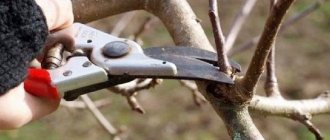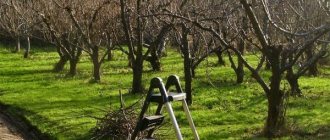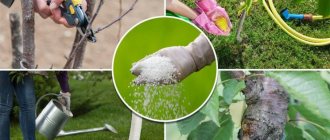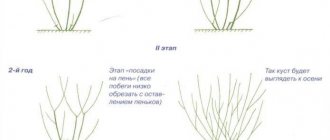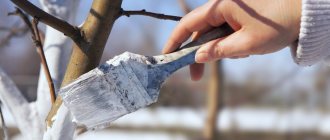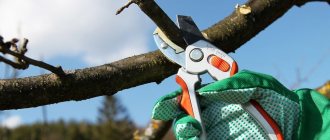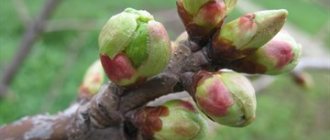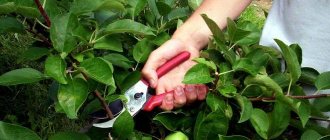Without timely and correct pruning of fruit trees, the gardener risks being left without a harvest. A crown that is too thick is poorly ventilated, light does not reach the trunk, that is, all the conditions develop for the activation of pathogenic microorganisms. In order to properly trim the branches of fruit trees - the way real professionals do it, you need to understand the basic principles and rules of crown formation.
How to decide on a tree pruning date
When asked whether apple trees are pruned in the spring, experienced gardeners answer in the affirmative. At this time, fruit trees tolerate the destruction of the bark least painlessly and, with the onset of sap flow, quickly recover from stress. It is important not to miss the time when to prune apple trees. Which month to choose, from late January to early April, is determined by the weather of the area. In frosts below -8 0C, procedures can cause irreparable damage to trees. Trees become very fragile and branches easily break under the weight of the tool, resulting in uneven wounds.
The timing of pruning apple trees in the spring is limited to the beginning of sap flow. A lot of sap can ooze through wounds at the site of large cuts. Trees weaken, become sick, are easily susceptible to pests, and fruit production decreases. In particularly difficult cases, plants may die. The best time to prune apple trees is when the temperature is near zero and the plants are still dormant.
Useful video
This video will tell you about when it is better to prune fruit trees - in spring or autumn?
Also watch the video for brief tips on how to perform autumn pruning of an apple tree:
And in this video, watch tips and secrets for autumn apple tree rejuvenation:
If you are interested in pruning an apple tree in the summer, then read about pruning schemes and timing by following the links.
Advantages and disadvantages of pruning in spring
Understanding what this procedure is involves realizing that pruning fruit trees brings only positive results. The benefits of spring pruning are obvious. She helps:
· form a beautiful tree;
· strengthen the skeletal branches and the central trunk;
· improve the productivity of fruit-forming shoots;
· increase the abundance of new fruit-bearing branches;
· extend the life of the tree;
· improve the quality of fruits.
However, there are also disadvantages, which are that it can be difficult for novice gardeners to determine the timing of the pruning operation. It is also worth considering that the results of anti-aging pruning will not be visible in the current season, but only in a year or even two. Removing a large number of shoots slows down the development of the tree and can lead to late fruiting.
Latest articles for gardeners, gardeners and flower growers
Orange peel as fertilizer
How to grow pepper seedlings at home step by step instructions
Lunar calendar for planting tomatoes in April 2022
Cypress pine juniper larch
Some advice from experienced gardeners
When working in your garden, consider the experience of other gardeners and do not forget:
- When removing branches, do not leave stumps, cut close to the trunk.
- A correctly made cut leaves a trace of a neatly overgrown “ring”.
- When removing thick branches, first make a cut from the bottom and then from the top. This way, the bark will remain intact if the branch falls.
- If the shoot was removed incorrectly, there is damage - clean it, treat the cut with varnish.
- It is better to wait until next spring to trim frozen trees.
- You cannot fill hollows or drill drainage holes.
- If there is a danger of branches breaking under the weight of the fruit, do not place supports. It is better to partially pick off the fruits. Otherwise, the plant will get used to it and will not be able to hold the branches on its own.
You will learn how to properly prune a plant without damaging it by watching the video at the end of the article.
Branch cutting technology
To properly trim a tree, you should familiarize yourself with effective cutting techniques:
- On the kidney. This technique makes it possible to redirect the growth of branches in the direction that the gardener needs. A growth-bearing one-year-old shoot is selected from the tree, which has a bud located in the required direction. In this case, the tool should be positioned so that its cutting part is near the remaining part of the shoot, and not near the cut end. It is recommended to make the cut at an angle, otherwise there is a high risk of damage to the kidney. If the cut is made too sharp, the transport of nutrients will be disrupted and it will die (dry out).
- On the ring. This method involves completely trimming branches that are growing in the wrong direction. Since the fruit tree wastes food on them, they are completely useless. If the thickness of the branch is small, then garden pruning shears will do. It is necessary to cut into a ring along the outer edge, which has the appearance of an overflow at the point where the branches connect. This is one of the ways to form crowns, where branches growing vertically and inside its mass are removed.
Why do this?
Fruit trees such as apple, pear and stone fruits especially need pruning, but they are very demanding in this process. Thanks to pruning, you can significantly reduce the overall dimensions of the crown, accelerate growth and increase fruiting of trees. This is how preventive measures are taken and unfavorable conditions are created for pests and diseases.
The procedure of pruning trees prolongs their life and helps to obtain a rich harvest.
If too little light reaches the crown, the branches that are inside the crown will not bear fruit and will eventually die off altogether. Fruits will form only on those branches that receive light. If trees are pruned rarely or not at all, fruit will only grow on hard-to-reach branches that are very high up.
The procedure is necessary for the correct formation of the crown, which allows the lateral branches to grow and thereby obtain a lot of harvest on the available branches.
Scheme of tree crown formation
The formation of the crown of fruit trees begins in the second year of life and lasts several years. Any pruning scheme will be difficult if the branches are not positioned correctly. In Russia, two methods are most common: sparse-tiered and tiered.
Let's consider the first: it is simple, accessible to novice gardeners and suitable for all types of fruit trees.
The first, lower tier is formed in the nursery, this makes the work of a novice gardener easier. When planting a seedling, you need to cut off all branches by 1/3. The root system is damaged when digging, and such pruning promotes the harmonious development of the plant. How soon after planting should you start forming the crown?
In the first year, a young fruit tree adapts to new conditions, roots develop, and therefore growth is small. In the second year, shoot growth will also be insignificant. From the third year after planting, start forming the crown.
In a sparsely layered system, the crown of a fruit tree consists of a central trunk and 5-6 branches located at different levels. On the right side of the schematic drawing, the structure is visible: each branch of the next tier is located in the middle of the angle formed by the lower branches. See the distance between tiers on the left side of the image.
How to prune grapes and other climbing trees?
Such plants can be pruned in the fall. The sap flows very actively through the vine bushes, so when pruning in spring, the plant loses a lot of liquid and physiologically active substances. This greatly inhibits growth and the plant loses its ability to produce berries.
It is recommended to trim the shoots of vines and other climbing trees in the fall, when the leaves fall. Choose the cutting pattern at your discretion. The simplest and most popular method in our climate zone is fan pruning, which is also suitable for beginners. In this way, the vines are easily formed and then sheltered for the winter.
Horizontal pruning is possible, but this type of shaping requires more experience and the plants will take up more space in the garden than with fan pruning. On the other hand, such pruning increases the yield of many types of grapes, the vines ripen well, and the bushes overwinter more easily. If you enjoy growing grapes and can spend more time caring for them, choose a horizontal cordon.
To form the crown of a fruit tree, follow the instructions:
Cut the central shoot (conductor) at a height of 80 cm from its base. The distance is approximate, the main thing is that there are 8-10 buds left on the conductor, from which new shoots of continuation and lateral branches are formed. This is how the first tier is formed.
The next year, inspect the seedling, remove frost-damaged branches, then select the 2 or 3 strongest. Cut off the rest. You have formed the second tier.
The third tier is formed according to the same principle for the 4th year.
As soon as the fruit tree reaches a height of 4 meters (if the variety is low-growing - maximum height), cut the conductor above the top strong branch: you will stop growth. The crown of the young tree is formed.
Remember that with the described method you cannot oppress the tree, eradicating the inherent characteristics of the variety.
The main difference between spring treatment
All garden care activities are carried out before the period of intense sap movement begins. The most appropriate moment would be when the movement has not yet begun, but everything is ready for it. This is due to the fact that the plants received injuries are capable of a speedy recovery then.
Latest articles for gardeners, gardeners and flower growers
Treatment of seeds with phytosporin before planting
Tomato varieties resistant to late blight for open ground
Pepper seedlings at home without picking
Treating seeds with hydrogen peroxide before sowing
To speed up the recovery of the plant, you can treat the cuts with a mixture of yellow clay and manure. They also use regular oil paint. This method brings the tree back to normal in just two weeks, and then callus appears on the cut. The main thing is that the average temperature does not fall below -5 degrees.
Trees should not be pruned before flowering. This is especially true for young seedlings that will bloom for the first time.
Further care
The places where the branches were cut are essentially the same for the apple tree as wounds on the human body: on the one hand, they threaten “blood loss” (leakage of juice), on the other hand, they increase the likelihood of infections, especially if liquid. In addition, intense evaporation of moisture occurs from the wound, which also negatively affects the general condition of the tree.
Therefore, caring for an apple tree after pruning, like caring for a patient after surgery, should include mandatory wound treatment.
Important! Cuts of thin branches up to 1.5–2.5 cm can be left untreated, but only if the tree is absolutely healthy.
Before applying a healing or simply blocking composition to the cut area, the cut must be cleaned in order to completely level the surface and remove burrs and wood “dust” from it. This procedure is best performed with a garden knife, while grabbing a small area of healthy tissue.
Then it is recommended to immediately treat the surface of the wound with a soft and clean brush with copper or iron sulfate (concentration 3–5%), potassium permanganate (saturated pink solution), Bordeaux mixture or solution of brilliant green (in common parlance - “green”), after which Allow the preparation to dry completely. Depending on the weather, this can take from 40 minutes to several days. It is advisable to process all sections - both thick and thin.
Video: Do I need to process cuts and cuts after trimming?
Only after this can you begin to “seal” the wounds left after removing thick branches. For these purposes, you can use the following tools:
- Garden var . This preparation is similar in color and consistency to wax. It can be easily purchased at any agricultural store, and, if desired, you can make it yourself by mixing rosin, paraffin and any unsalted animal or vegetable fat in a ratio of 4:2:1 and boiling the resulting substance for 10 minutes. Wax in this recipe is sometimes replaced with turpentine, and fat with drying oil.
- Paint based on natural drying oil.
- Boltushka made from mullein and clay (the consistency of very thick sour cream).
- Cement, liquid nails, polyurethane foam (the options are not the most environmentally friendly, but sometimes, in the absence of other means, they are used).
- Special balms-varnishes (the so-called “artificial bark”). This product is ideal from the point of view of effectiveness, however, these types of drugs are quite expensive, and besides, they cannot be purchased everywhere.
Important! It is not recommended to use water-based paints for processing saw cuts, since after the first rain there is practically nothing left of them on the cut. In addition, some varnishes and paints contain chemical solvents that, penetrating into the wood, poison the wood.
Processing can be carried out using a brush, spatula or an ordinary knot wrapped in soft cloth. For additional disinfection, you can add crushed wood ash or one of the special preparations that accelerate scarring processes, for example, Heteroauxin or Rannet, to the garden varnish.
After processing, the cutting areas of especially large branches can be additionally protected from frost by wrapping them with burlap or agricultural fiber.
After proper processing, the cut gradually overgrows in the form of a bark ridge, the formation of which begins from the edges. Over the course of a year, the area of the cut branch with an area of 2-3 cm² is completely retracted, while in the absence of treatment this process is at least twice as slow.
If the apple tree has been pruned radically, over the next year it needs especially careful care, including strict adherence to the watering and fertilizing regime, as well as crop rationing.
Did you know? In order to meet the oxygen needs of two people, just one mature tree is enough. It also absorbs the amount of carbon dioxide that an average car produces in almost 50,000 km.
Pruning berries and fruit crops
Pruning of cherries and plums should not be forceful. After the procedure, all sections are covered with garden varnish to avoid gum formation, which is dangerous for stone fruits.
It is better not to prune the hazel tree, since the shoots, which are loose by nature, tend to dry out after partial removal. If shoots are damaged by frost, do not rush to prune. You need to wait for the moment when a shoot develops from the remaining living eye, and after it grows, cut off the dried part of the shoot.
Raspberries have strong root shoots that produce a larger harvest the following year. And on a two-year-old shoot, only the branches that extend from below to the height of the stem bloom and bear fruit, so that its upper ¼ part is usually barren. In the spring, dry branches are removed from two-year-old shoots that already produced a harvest last year. Then the four best ones are selected from the annual shoots, and the rest are cut out at the base. Leaving a larger number of shoots is unprofitable - you get more berries, but small ones and of poorer quality. You should make sure that the shoots left for fruiting are healthy before cutting out small but full-fledged shoots that can replace them. Stems damaged by frost have cracked bark. Last year's four best shoots are shortened by their lengths.
Do I need to treat the cuttings with garden varnish?
Garden var is very good for spring pruning. After it, it simply wonderfully helps the trees heal where they were cut and protects them from pests.
As for whether it is necessary to treat saw cuts with garden varnish in the fall, it is better not to do this. The wood needs to be treated, but it is wiser to do this with oil paint. Garden varnish in winter will be ineffective and practically useless. It will pill and crack. Therefore, it is better to take paint as a more reliable coating. And oil paint is better, because it is intended for wood.
There is one more important rule: You need to treat saw cuts with paint or garden varnish a couple of hours after trimming the tree. Why? Because the wood needs to dry out. Agree, painting wet furniture or wet gates is not the best idea.
Sometimes you need to apply a second coat of paint after the first layer has already dried. Especially if at the bottom of the cut you see that juice has appeared.
As for small branches, up to a centimeter in diameter, it is believed that the cuts after their removal need not be processed at all. More precisely, this can be left to your own discretion. If you have extra paint and time, then paint over them, but if not, then don’t.
Processing cuts with paint
Pruning mature fruit trees
Your garden is already bearing fruit. But it, like young trees, requires care and removal of dried or diseased branches. How to properly prune fruit trees in spring?
The thickened crown of a fruit tree needs to be thinned out. After five years, the conductor is removed. This will limit upward growth. Remove the branch completely or partially. Partial removal will promote the growth of the branch that is located nearby. It is also necessary to cut off diseased, dried branches - the illumination of the crown improves, the fruits are distributed evenly.
Pruning is best done when the tree is dormant, before sap flow begins.
If the crown is pyramidal (pear - branches grow upward), the growing branches need to be lowered down: those that are directed downward are left, and those that are directed upward are cut off. In other fruit trees, the branches are directed downwards - they need to be lifted: remove the ones pointing downwards.
To rejuvenate a tree, you will need to cut out the upper part of the trunk and thin out the crown. To do this, you should remove the old branches going inside the crowns that are intertwined. A very dense crown should not be thinned out overnight, so as not to seriously injure the plant; spread out the operation over two to three years.
Pruning an apple tree for beginners - what should be removed first:
· Dried and broken branches;
· One of the closely located branches is weaker;
· Vertically located fatty shoots - tops;
· Branches growing at an acute angle.
More rules for beginners
You need to cut it into a ring.
The knife and saw must be sharp.
If part of a branch is removed, cut above a strong bud.
There is some debate about the need to treat cuttings, but when pruning in spring, treating with a fungicidal paste is more advisable than not.
When and how should trees and shrubs be pruned?
In autumn, when the leaves fall, fruit and ornamental trees growing in the garden should be pruned.
Branches can be pruned as early as mid-October, without waiting for all the leaves to fall. There is no exact date for exactly when pruning should be completed, so common sense must be used.
It is not recommended to work in the garden and trim plants when it is raining, because at this moment the ground is wet. Trampling on wet soil around trees and shrubs can damage its structure and make it difficult for oxygen to reach the roots. If you are going to work in bad weather, at least place boards under your feet to reduce compaction of the earth.
Prune grapes, roses and other shrubs that need to be covered for the winter so that all work is completed before they are covered.
Pruning pears in spring
In fact, spring pruning of pears is not much different from pruning an apple tree. The formation patterns of both trees are approximately similar.
The main difference is that if the branches of an apple tree are cut into a ring, then those of a pear tree are cut into a side shoot. The fact is that severe pruning of this crop provokes excessive formation of tops.
Latest articles for gardeners, gardeners and flower growers
The most productive potato variety for the Middle Zone
How to plant a rose using cuttings from a bouquet
Sowing eustoma seedlings in peat tablets
When can you sow tomatoes for seedlings in 2022 according to the lunar calendar?
Like an apple tree, a pear tree is pruned for the first time immediately after planting: the central conductor is shortened to 80-90 cm and all the side shoots of the seedling are cut off.
Starting from the second year, young pears are formed so that the tree has several tiers of 3-5 fan-shaped skeletal branches in each, subordinate to the central conductor (they should be 20-25 cm below the central conductor).
Pruning old pears includes not only the removal of frozen, dry, damaged shoots, but also the pruning of all side branches that grow vertically or inward and compete with the skeletal branches.
To force a branch that has begun to grow upward to develop horizontally, it is pruned to a strong outer lateral bud. If necessary, also tie the branch to a peg stuck in the ground to bend it a little. This method is good for old pears with a thickened crown, which may not survive heavy rejuvenating pruning.
This video will show you how to do this with the least stress on the tree:
Rejuvenation of old apple trees
Sometimes gardeners are in no hurry to get rid of old apple trees for some reason, for example, if it is a valuable variety that has nothing to replace it with. You can increase the yield of such an old apple tree using rejuvenation - a special pruning technique. The actions are performed in the same way and according to the same rules as when thinning the crown, only you need to remove the maximum number of branches. In this case, the branches should be shortened by no less than two-thirds of their length. As with the lightening of the crown, many tops begin to grow. They also need to be removed, leaving the growing ones more hollow, further pulling them back. These shoots should be greatly shortened for two to three years in a row to stimulate fruiting.
When rejuvenating pruning, it is imperative to leave one skeletal branch untouched for 2–3 years. The leaves growing on it will intensively photosynthesize, supplying nutrients to the entire tree until a new full-fledged crown develops from the remaining tops.
Another rule that gardeners should remember: pruning should only be done on healthy trees. In weakened trees, wounds heal slowly and there is a high risk of infection. As a result, the tree may wither and die.
